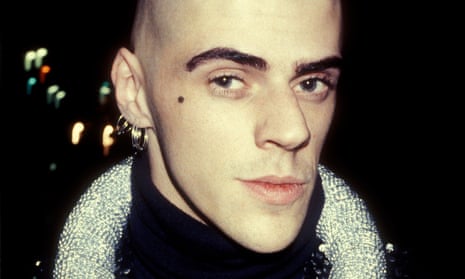Punk turned Judy Blame on when he was a teenage Chris Barnes living on a farm in 1970s Devon, with no night life, not much day life, and nobody around who appreciated punk’s homemade aesthetics. The movement’s ideal that you could, should, create your own everything, especially lifestyle, out of what might be foraged in an urban environment, sustained his life until his sudden death at 58, and kept him engaged as jeweller, art director, and adviser on street style to designers including Riccardo Tisci, Rei Kawakubo, Kim Jones at Louis Vuitton and Jeremy Scott at Moschino.
He was self-taught in style. When he was five, his father took a job in Spain importing precious metals, and moved the family from Leatherhead, Surrey, to Madrid, where Blame spent his Saturdays happily alone looking at art in the Prado museum. The move back to a farm on the edge of Dartmoor just in time for secondary school was glum, his cultural sustenance reduced to glam rock posters of David Bowie on the bedroom wall and a record shop next to Exeter bus station. At 17, he dyed his hair orange, saved the train fare to London, and made for the World’s End punk HQ Seditionaries, where Vivienne Westwood sold him bondage trousers and showed him how to do up the straps.

He was overwhelmed by London, and after a week fled to Manchester to stay with former schoolfriends, now students. His chief concerns were a wildly individual appearance achieved on the dole by reworking jumble sale finds, and a punk or reggae venue to show it off in.
After two years, he made a confident return to London as its punk scene mutated into New Romanticism, and joined a gang of creatives hanging round chosen shops and clubs, including Blitz and Heaven, that had barely any division between performer and audience. He DJ’d, and checked coats for a chance to meet people, notably the film director Derek Jarman, his guru and social godfather. The designer Antony Price renamed the striking gawk Judy, after Judy Garland, and the club host Scarlett Cannon added Blame. He loved it: it sounded “like a bleached-blonde tart from a B-movie”.
Blame had been making jewellery since he first threaded conkers into a necklace, so he accessorised the only good outfits he and Cannon owned by improvising mad adornments from a zillion beads, string, or bones scavenged from Thames mud. The Culture Club singer Boy George gathered up Blame swag for a tour; Blame transformed extras on the Duran Duran Wild Boys video into a Mad Max mob with the contents of Hoxton binbags. With his friends the fashion designer Christopher Nemeth and shoemaker John Moore, he formed the House of Beauty and Culture, a craft collective in cheap premises in Dalston, east London.

When he had to haul House goods to photo sessions, he arrived with strong opinions about the visuals, and gradually, backed by the photographer Mark Lebon, and pioneer stylist Ray Petri of the Buffalo collective, began to set up shots himself for the Face and i–D magazines. This led to art direction of videos for musicians he knew, including fellow clubgoer Neneh Cherry, dressing them in a novel mix of top-end ready-to-wear (Martin Margiela, Azzedine Alaïa), sportswear including his beloved stripy Adidas, global tat bought along the Kingsland Road, and bling assembled from his boxes of rubber washers, clock innards and bottle openers. He never gave up on punk’s safety pins, calling them design genius; they underpinned the great collage of his 2016 ICA retrospective show, Never Again.
Blame styled albums for Massive Attack and Björk, and brokered encounters between fashion creators, unworried by lack of a formal job, let alone big money; after years of squats and dosses, just visiting the Paris shows or his favourite, Brazil, or having a well-lit flat to store his enormous button collection, were enough. “I’ve never got bored with a button,” he said. His jewellery was regularly seen at couture shows and occasionally in retail – Dover Street Market in London (a Mayfair upgrade of the old collectives) awarded him a stall; he styled objects – such as packaging for Jo Malone – as much as people.
There was never a career plan. “I like waking up every day to do something. Hasn’t done me any good whatsoever but I’ve enjoyed it.” Blame survived drugs problems to become a generous mentor to a new fashion generation; as he aged, he looked curiously like an elegant version of his old mentor Jarman.
He is survived by his brothers, Robert and Nicholas, and sisters, Jane and Jenny.

Comments (…)
Sign in or create your Guardian account to join the discussion